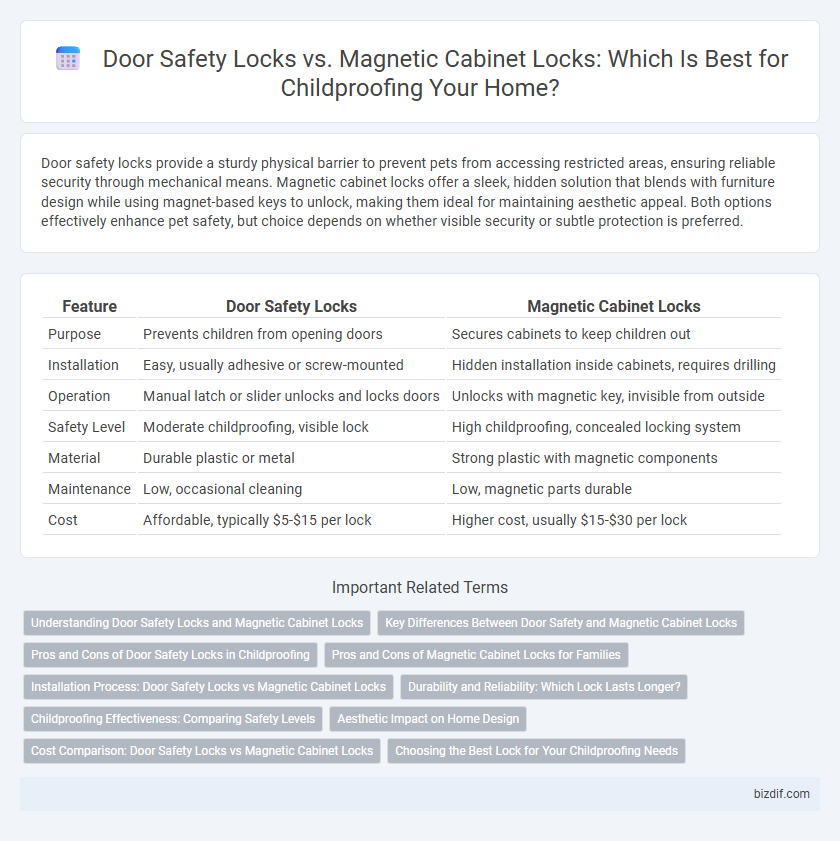Door safety locks provide a sturdy physical barrier to prevent pets from accessing restricted areas, ensuring reliable security through mechanical means. Magnetic cabinet locks offer a sleek, hidden solution that blends with furniture design while using magnet-based keys to unlock, making them ideal for maintaining aesthetic appeal. Both options effectively enhance pet safety, but choice depends on whether visible security or subtle protection is preferred.
Table of Comparison
| Feature | Door Safety Locks | Magnetic Cabinet Locks |
|---|---|---|
| Purpose | Prevents children from opening doors | Secures cabinets to keep children out |
| Installation | Easy, usually adhesive or screw-mounted | Hidden installation inside cabinets, requires drilling |
| Operation | Manual latch or slider unlocks and locks doors | Unlocks with magnetic key, invisible from outside |
| Safety Level | Moderate childproofing, visible lock | High childproofing, concealed locking system |
| Material | Durable plastic or metal | Strong plastic with magnetic components |
| Maintenance | Low, occasional cleaning | Low, magnetic parts durable |
| Cost | Affordable, typically $5-$15 per lock | Higher cost, usually $15-$30 per lock |
Understanding Door Safety Locks and Magnetic Cabinet Locks
Door safety locks provide secure mechanical barriers that prevent children from opening doors, often using latch or lever mechanisms suited for external doors. Magnetic cabinet locks rely on hidden magnetic components that require a special magnet key to unlock, ensuring cabinets remain childproof without visible hardware. Both options prioritize safety by restricting access, with door safety locks designed primarily for entry points and magnetic locks tailored for cabinets and drawers.
Key Differences Between Door Safety and Magnetic Cabinet Locks
Door safety locks primarily focus on securing entrance doors to prevent child access, offering strong mechanical resistance and often featuring key or code entry for controlled access. Magnetic cabinet locks use hidden magnetic mechanisms activated by a special key, ensuring cabinets stay securely closed without visible locks, making them ideal for childproofing kitchen and bathroom storage. The key difference lies in their application: door safety locks handle larger, exterior access points, while magnetic locks provide discreet safety for smaller indoor cabinets.
Pros and Cons of Door Safety Locks in Childproofing
Door safety locks provide a reliable physical barrier to prevent children from accessing hazardous areas, featuring easy installation and durable materials that withstand repeated use. However, they can be less flexible than magnetic cabinet locks, often requiring manual operation and potentially causing frustration for adults during frequent use. While door safety locks offer strong security, they may limit quick adult access, making them less convenient in high-traffic areas compared to magnetic locking systems.
Pros and Cons of Magnetic Cabinet Locks for Families
Magnetic cabinet locks provide an effective childproofing solution by offering strong, hidden security that prevents toddlers from accessing dangerous items while maintaining aesthetic appeal. These locks are easy for adults to operate with a magnetic key but can frustrate users without the key, potentially causing inconvenience during frequent use. Families benefit from the durability and discreet design, but must consider the initial installation effort and the need to keep the magnetic key accessible yet out of children's reach.
Installation Process: Door Safety Locks vs Magnetic Cabinet Locks
Door safety locks typically involve straightforward installation with adhesive backing or simple screw mounts, making them quick to set up on a variety of door types. Magnetic cabinet locks require drilling and mounting a magnetic catch inside the cabinet, which may take more time and precision for proper alignment but offers a hidden locking mechanism. Both options provide effective childproofing, though magnetic locks often demand a more detailed installation process compared to the simpler application of door safety locks.
Durability and Reliability: Which Lock Lasts Longer?
Door safety locks typically offer superior durability due to their robust mechanical design and high-quality materials, making them resistant to frequent use and wear. Magnetic cabinet locks rely on magnets and adhesive components, which may weaken over time, potentially reducing their reliability in high-traffic areas. Choosing door safety locks ensures longer-lasting protection and consistent childproofing performance.
Childproofing Effectiveness: Comparing Safety Levels
Door safety locks provide robust physical barriers that prevent children from opening doors, ensuring reliable containment in hazardous areas. Magnetic cabinet locks offer high childproofing effectiveness by requiring a hidden magnetic key to unlock, combining security with convenience for adults. Both solutions excel in enhancing home safety, but magnetic locks typically provide superior protection for cabinets with potentially dangerous items.
Aesthetic Impact on Home Design
Door safety locks offer a subtle and often less visually intrusive option for childproofing, blending smoothly with existing door hardware and complementing various home design styles. Magnetic cabinet locks remain hidden inside cabinets, preserving the clean lines and aesthetic integrity of modern kitchens and living rooms without visible hardware. Both options prioritize safety, but magnetic locks excel at maintaining an uncluttered, minimalist appearance crucial in contemporary interior design.
Cost Comparison: Door Safety Locks vs Magnetic Cabinet Locks
Door safety locks typically cost between $5 and $15 per unit, making them a budget-friendly option for securing entry points. Magnetic cabinet locks range from $20 to $40 per unit, reflecting their advanced design and enhanced security features. Choosing between these options depends on budget constraints and the specific safety requirements of the home.
Choosing the Best Lock for Your Childproofing Needs
Door safety locks provide robust physical barriers that prevent children from opening doors and accessing unsafe areas, ideal for high-traffic zones. Magnetic cabinet locks offer discreet protection with hidden mechanisms activated by a magnetic key, perfect for maintaining aesthetic appeal in kitchens and bathrooms. Selecting the best lock depends on balancing visibility, ease of access for adults, and the specific areas requiring childproofing protection.
Door Safety Locks vs Magnetic Cabinet Locks Infographic

 bizdif.com
bizdif.com